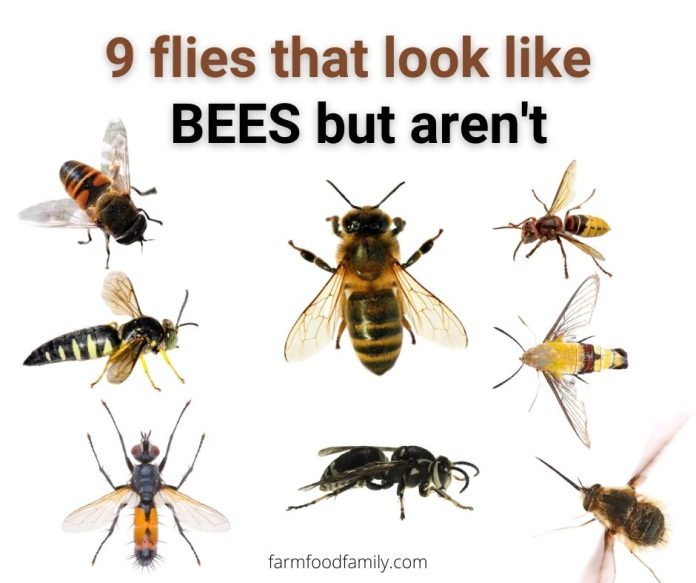9 Flies That Look Like Bees But Aren’t (With Pictures)
We all know that bees love flower gardens, and they have their signature buzzing to indicate their arrival. But sometimes, not all that buzzes, with stings, and have striped bodies are all bees. Interestingly, some of them are species of flies. Yes, you read that right and, in this post, we rundown some flies that look like bees.
If you are wondering about how flies could look like bees, we list in here some characteristics that make bees and these fly species similar and some identifying characteristics to differentiate them. So, without much ado, read on.
Related: An Herb Butterfly And Bee Garden: Herb Gardening with a View Toward Attracting Insect Pollinators
In this article:
Bee facts
Before we dive into the flies that look like bees, let us first look into some bee facts that would make you understand why it is important to determine bees from bee lookalikes.
- One bee produces 5 grams of honey in its lifetime.
- For a kilogram of honey to be produced, bees must fly around flower beds an equivalent of three times around the world measured in miles.
- The flavor of the honeybees produce depends on the flowers they land on for nectar.
- Male bees die after mating and the mating process takes place high in the sky.
- Queen Bees produce at least 20000 eggs per day. The fertilized eggs will become female bees while the unfertilized ones develop into male bees.
- Bees are particularly attracted to blue and purple flowers. They also love landing on flowering plants with a clustering habit.
- Unless really disturbed or threatened, bees don’t sting humans because doing so would mean their death.
- Bees are considered as partially domesticated and are the only social insects to be treated so.
- Crops that depend on pollinators like bees are five times more valuable than crops that do not.
- The natural habitats of bees include boggy sites, marshlands, dunes, heathlands, grasslands, quarry sites and abandoned, post industrial lots.
Flies that look like bees
There are not many flies that look like bees, but they are just so notably alike at first glance that it becomes understandable as to why one could count them as bees without verification. Some of the most mimicked bee species by flies would be carder bees and species of bumblebees. To cut the chase, here are the flies that look like bees.
1. Hoverflies (Syrphidae)
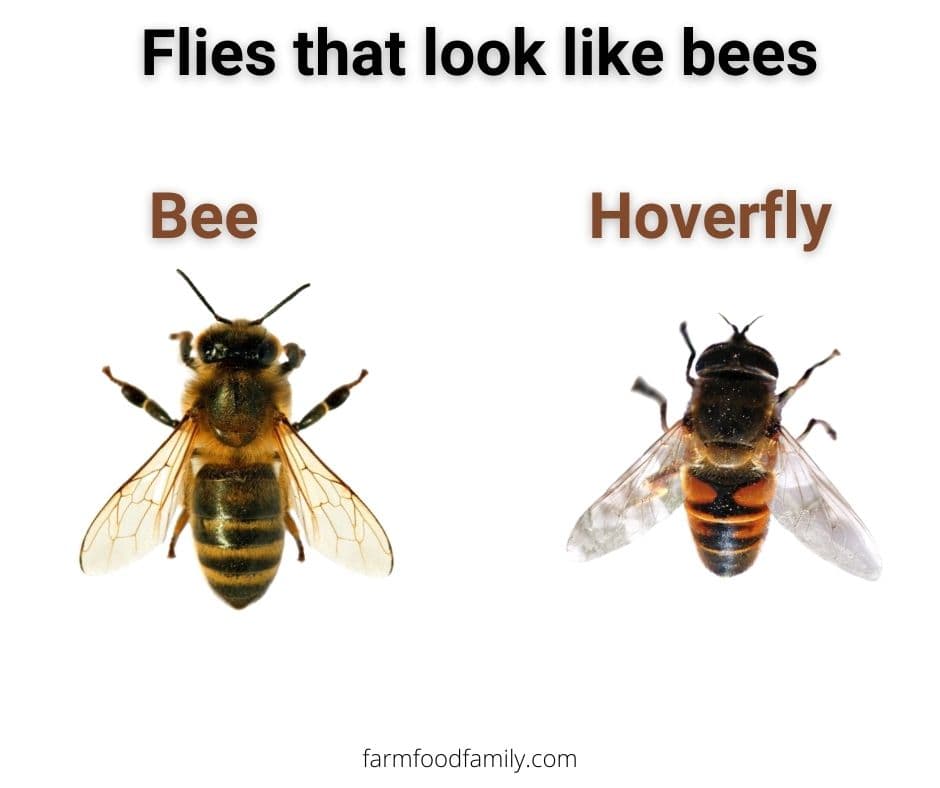
There are different species of hoverflies but there are notable ones that really look like bees because of their yellow and black coloration. They can also be mistaken for them because of their size and behavior.
They usually grow at a length of 5-15mm, with large heads and two marbled eyes like bees. Their yellow coloration by the thorax also makes them bee look-alikes.
Perhaps, the main distinction would be that hover flies are hairier than bees. In terms of behavior, hover flies buzz like bees do and literally hover around flowers where bees usually land and suck the nectar of the flowers that bees get nectar and pollen. Hover flies can be used in pest control, specifically for aphids.
Related: 10 Plants That Repel Flies Naturally and Keep the Home Bug-Free
2. Bee-flies (Bombylius)
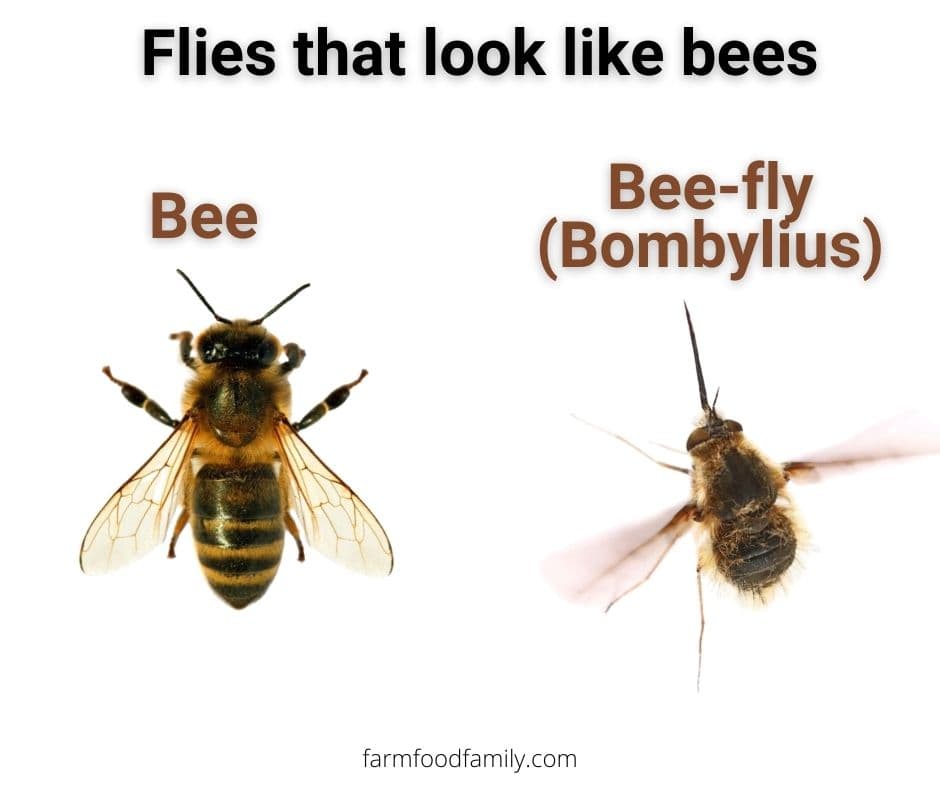
This one is really a notable bee lookalike. Specifically, these small flies are similar hairy footed flower bees and brown carder bumblebees. They also share with bees the same hovering habit, same level of hairiness and suck on the nectar of the flowers that bees love.
They are quite tacky too. They lay their eggs on holes dug by mining bees and feed on the pollen that they have stored there. But they are easy to differentiate from bees too. One, they only have one pair of wings, they have no constricted waist, they have shorter antennae, no mandibles for biting, and have smaller eyes.
Related: 7 Butterflies That Look Like Monarchs
3. Parasitic flies (Tachinidae)
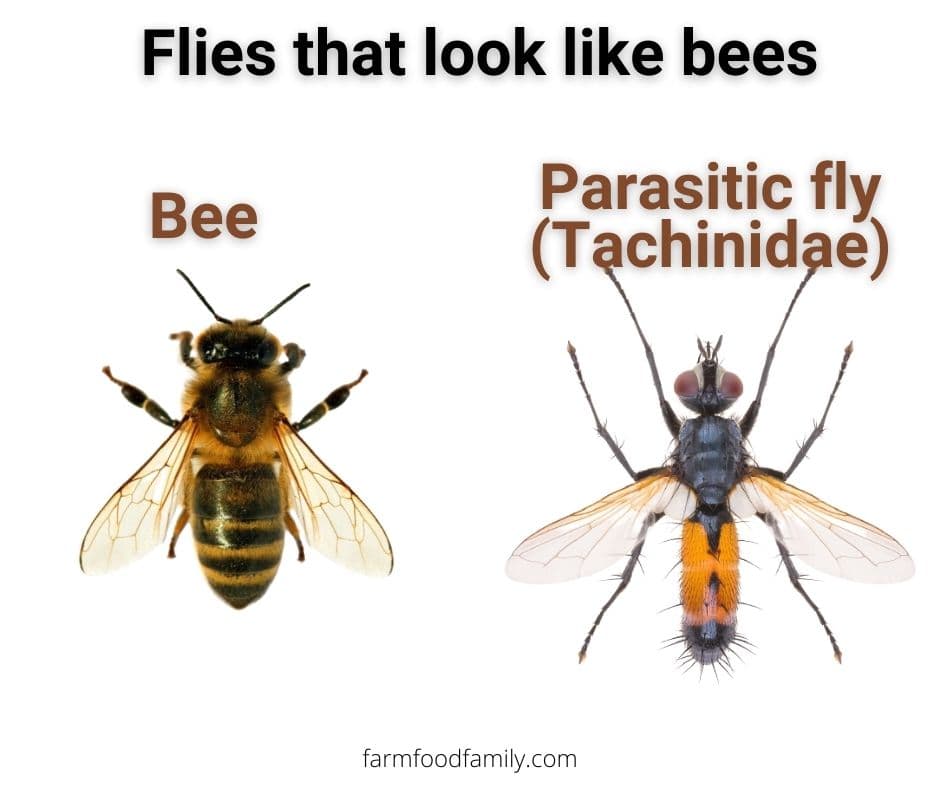
This one is considered as the largest British fly and they can easily blend in with black bumblebees or wool carder bees due to their yellow sides. They are also known pollinators like hoverflies and bees. They get their name for their habit of laying their eggs on other insects. When the eggs hatch and become larvae, they would feed on their insect host.
Their differences with bees include having a large, bulb-like head, absence of narrow waist, short antennae, bristly rather than hairy bodies, no mandibles, single pair of wings that do not fold, and their eyes take most space in their head.
Related: How to Get Rid of Wasps
4. Wasps (Aculeata)
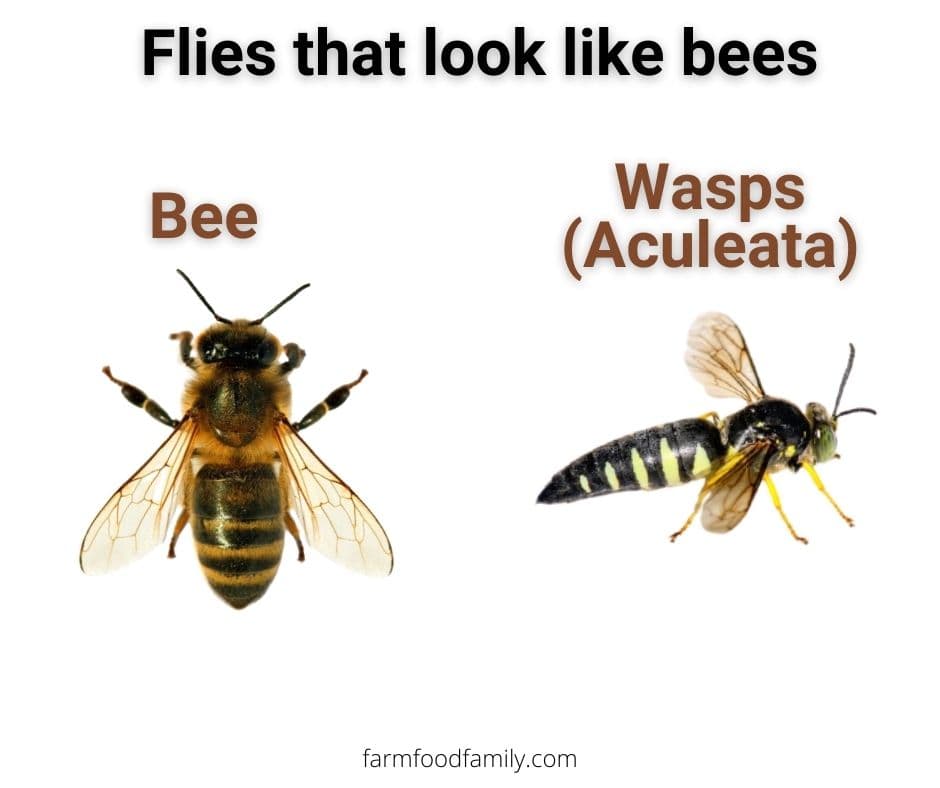
At first glance, sure, wasps can look like bees because both have four pairs of developed wings. They also have a yellow coloration by the abdomen, but their mahogany brown color gives them away. Both bees and wasps also feature the same constricted waist, but wasps have a more visible one and are less hairier than bees.
In terms of pollen and nectar collection, both bees and wasps use their hind legs or carry pollen underneath their abdomens. In terms of color patterns, wasps are more notable for their brighter colors and more variations when it comes to patterns compared to bees.
Related: 17 Best Plants That Repel Wasps And Bees
5. Bee beetle (Trichius fasciatus)
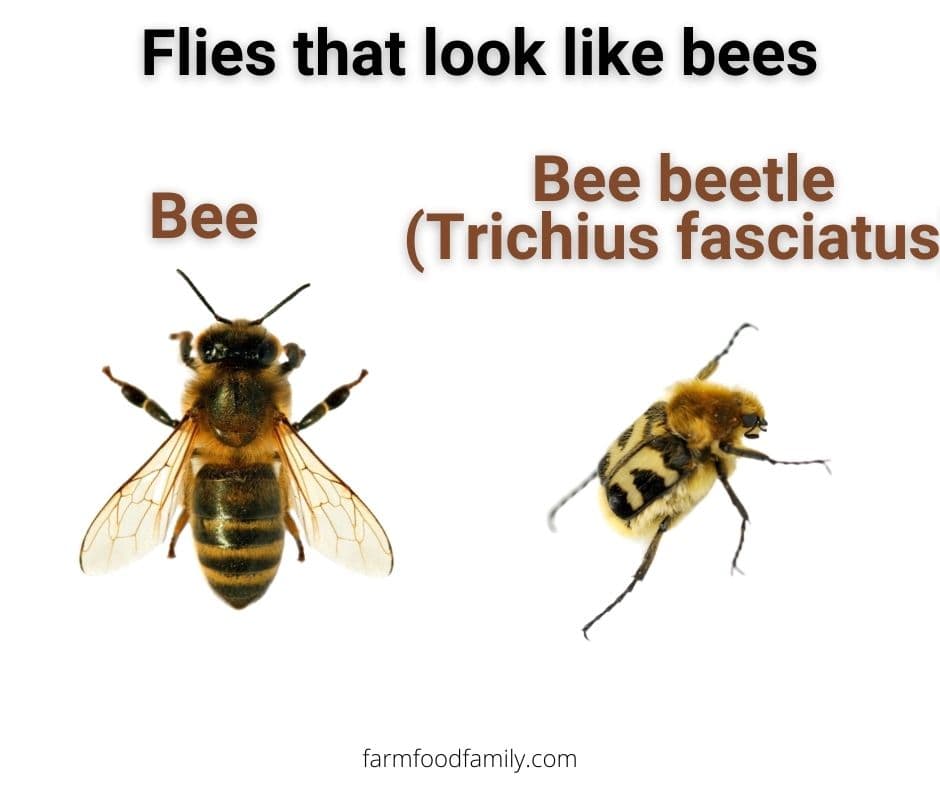
As the name suggests, the bee beetle at a glance, looks like carder bees and even small bumblebees thanks to their hairy heads and yellow and black coloration. Other than that, bee beetles have a hard forewing protecting their one pair of flying wings while bees have two pairs of translucent wings.
Compared to bees, bee beetles are smaller, growing at just 10mm long. Its native habitats would be gardens and meadows and their favorite flowers would be roses and the blooms of thyme. The color variation of bee beetles includes dull to bright orange too.
6. Hornets or yellowjackets
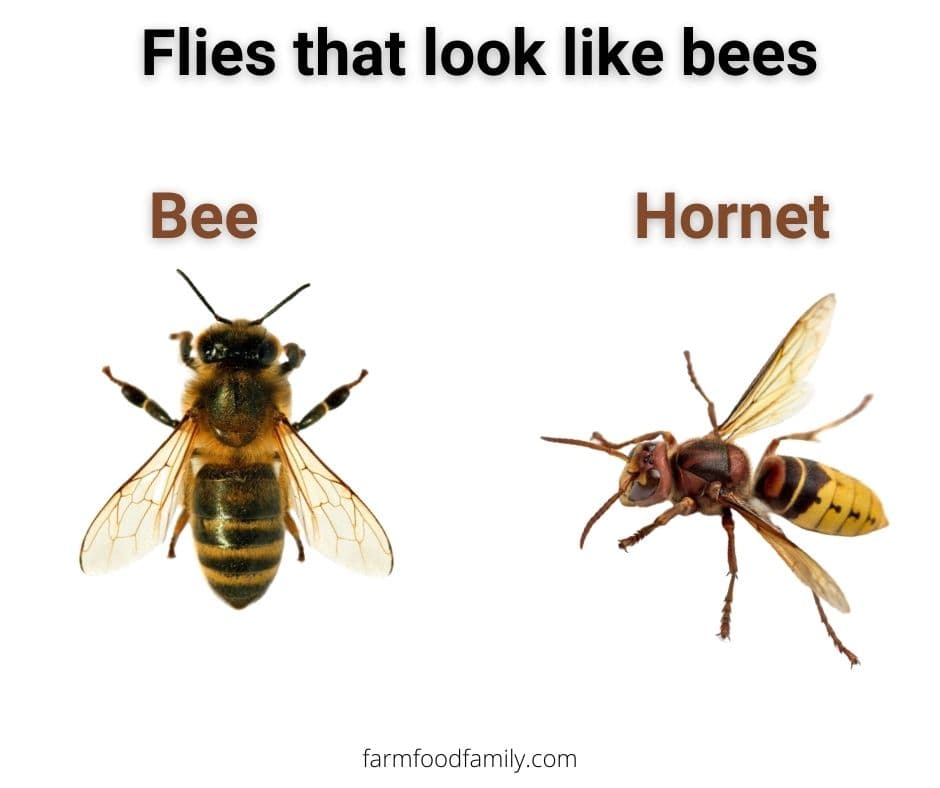
The resemblance between hornets and yellowjackets is so uncanny making them hard to differentiate. As a pair, they are also often mistaken for honeybees because of their yellow and black coloration. But in terms of habit and other characteristics, you can easily spot which is which.
For one, hornets and yellowjackets can sting aggressively, without reason and even multiple times compared to the one-time big-time sting of bees. Aside from this, hornets and yellowjackets do not have hairy bodies. They also scavenge for food other than nectar and they also prey on smaller insects in the garden. Unlike bees, they do not collect pollen.
7. Cicada killers
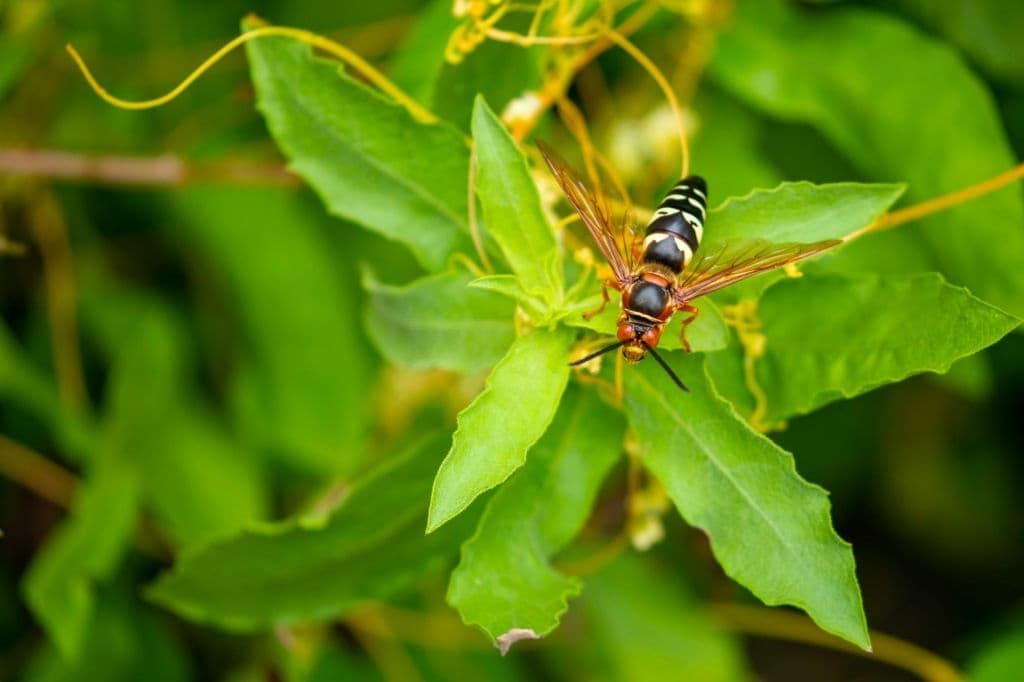
This one is a species of wasp which sport glossy, long and ovate black bodies with yellow segments. The most observable difference that cicada killers have with bees would be their one pair of brown, fly-like wings, their reddish pair of eyes that are apart.
Like bees, they hover at flight, and they also have a stinger which can sting you, by the way, if you disturb them. This, however, is just used for preying on cicadas, hence, the name. They also usually hang out in concrete slabs, lawns, golf courses, and around the garden.
8. Hummingbird clearwing moths

This, perhaps, is the most interesting bee look alike because it somewhat looks like a bee because of its yellow and black color but behaves like a hummingbird as it hovers on top of its food and with their pair of wings flapping fast like hummingbirds.
Unlike bees, this moth sports an opaque pair of wings. But they are sometimes mistaken for bees because they land on the same flowers and are usually seen sucking nectar side by side in the garden. They, however, do not sting like bees and are found to be jumpier and more skittish in the presence of humans.
Related: 38+ Different Types Of Moths (With Names and Pictures)
9. Bald-faced hornets
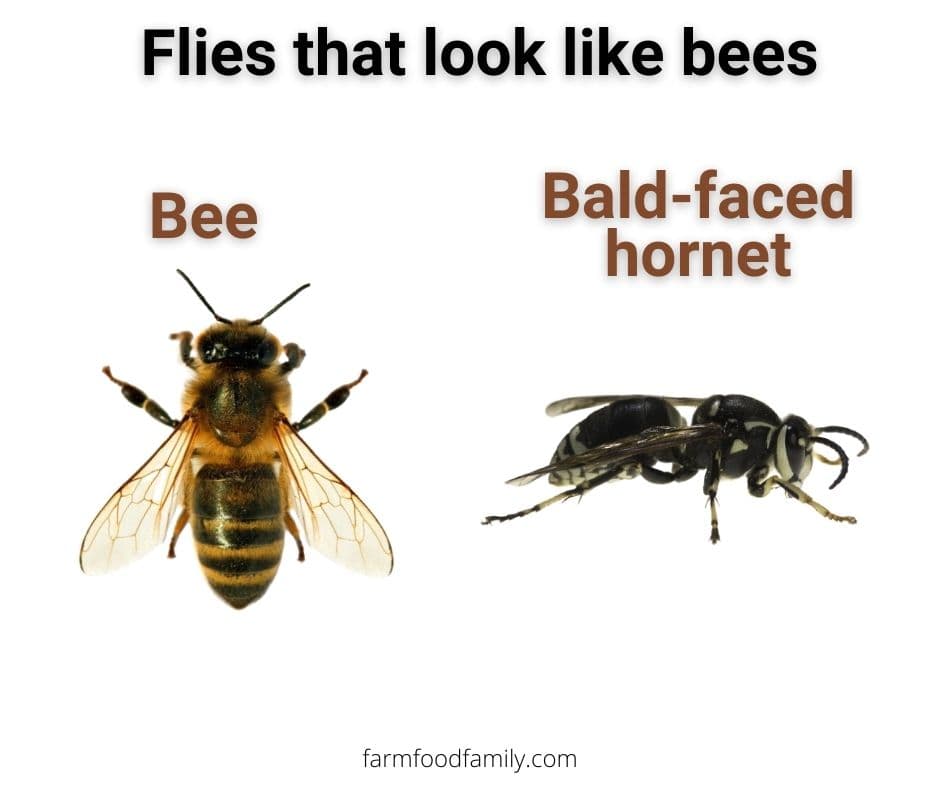
The only similarity that this one has alongside bees would be its yellow segments and hairy legs, hovering around flower gardens during spring and summer and their stings. They may suck nectar like bees do but they are also known carnivores, feasting on the carcasses of dead animals like deer and horses.
It is considered dangerous by environmentalists and for some good reasons. For one, they are aggressive stingers, and their stings could paralyze humans. Another is that they have good memories so if they do not sting you now but surely, they will come for you later. These hornets are also predators to bees.
FAQs
Why are bees important to the planet?
Here is the thing about bees: there are more of them in number than any type of pollinating insect and the world and for that, bees are responsible for the production of one third of all the food crops that we consume every day. For this alone, we can now know how important bees are to us.
To add to this, here are other reasons as to why we should also take part in bee conservation:
- Bee products are known to be natural remedies in reducing chances of developing cancerous tumors. These products include not just honey but also royal jelly and even bee venom, among others.
- Buzzing bees that do not hover around flowers indicate a coming thunderstorm. The ability of bees to navigate around is based on the electric waves from the earth’s magnetic field. Any disturbance in the frequencies causes bees to buzz erratically.
- Bees are low-key major contributors to the world economy. From crop production alone, they are already contributing $5.7B annually. Honey on its own, dozes in around $10B a year from around health and wellness, cosmetic and fragrance industries. With these, bees also generate jobs for people.
Are bees endangered?
At the height of the discussion over climate change in the last decade, the conservation status of bees has been widely discussed too. While honeybees are greatly protected because of their economic contribution, some bee species have been tagged as endangered while others are now close to extinct.
To date, there are 46 listed endangered bee species. This includes the rusty patched bumblebee and the Hawaiian yellow faced bee. International conservation groups and non-profit organizations hold annual summits in mitigating the dwindling population of endangered animals including bees.
What are the causes behind bee endangerment?
The factors affecting bee endangerment are not different to the overall causes of flora and fauna endangerment in the world today. At the forefront would be deforestation and climate change which fundamentally destroys key bee habitats in the globe.
Overharvesting of honey and the use of chemicals in crop production like the Monsanto case also altered the stability of bee populations.
It is also said that the advent of WiFi and 5G technology has affected their capacity for navigation because they are disturbing the magnetic field of the earth. This has not yet been proved scientifically but it is an interesting theory.
Do bees have cultural and spiritual significance?
Yes, and in different ways across various cultures. The image of the beehive has a high spiritual symbolism as it is associated to unity, continuity, regeneration, and spiritual connection.
In the Mediterranean civilizations, the bee and the bull are symbols of fertility and reproduction. Honey and bees are central to the ancient Egyptian belief system as they are incorporated in nobility, medicine, rituals, and magic.
Among the Hindus, Imme, the bee god is worshipped. They are also revered in Ireland and Scotland and across all British Isles before the dawn of the Middle Age. Generally, bees are considered as bringers of positive energy and harbors spiritual messages.
Do flies attack bees?
Regular flies do not but a certain species called parasitic flies, which by the way we have mentioned in the list, do not only attack bees but also prey on them. Their favorite bees to attack and feed from would be bumblebees. Reports also show that they have exhibited newfound liking to honeybees and are being closely monitored by honeybee growers.
How do I attract bees to my garden?
Now that you know the wonders of bees, you might want to heighten their presence and other pollinators in your garden. To do so, you can consider the following tips:
- Veer away from pesticides: No matter how they are labeled, most pesticides are still non-selective. If they can kill off pests and other insects, so would bees.
- Plant native flowering plants: Not only do native flowering plants exhibit higher adaptability but research also shows that they are five times more attractive to pollinators than non-native plants.
- Plant strategically: In the same vein, bees are also attracted to colorful flowering plants and those that bloom flowers in clumps or clusters. The favorite flowering plants of bees are those with blue, purple, white, pink, and yellow colors.
- Consider flowers with different shapes: Note that in North America alone, there are already 4000 different kinds of bee species. Each differs in terms of body size, shape, tongue length and manner of collecting pollen or nectar. Having different flower shapes can help diversify the bees in your garden because you get to satisfy the different needs of different bee species.
- Make your garden bloom all-season: Planting flowering plants that do not bloom all at once is strategic in making bees at home in your garden. They can associate your garden to offer a year-round supply of nectar and pollen. In this way, you do not only create a standout garden but also support the life cycle of different bee species.
- Plants where bees usually land: Observe the landing spaces of bee species. Most often than not, they are found in shady areas but mostly on sunny spots. Place flowering plants in these locations so they can get pollen and nectar undisturbed.
What are the native flowers to plant for bees?
You can always check native flowering plants based on your location, but the following would be the common bee native flower favorites for your reference:
- Aster
- Black-eyed Susan
- Caltrop
- Goldenrod
- Huckleberry
- Lupine
- Oregon grape
- Purple coneflower
- Rhododendron
- Sage
- Snowberry
- Stonecrop
- Sunflower
- Wild buckwheat
- Wild lilac
- Willow salix
Other garden plants that bees love to swarm on because of their scent or color would be the following:
Which crops are helped by bees?
The answer to this is probably thousands as they range from salad greens, root crops and more. Since it is said that bee pollinated crops are five times more valuable than those that are not, here are some of the most notable and common crops pollinated by bees.
- Almonds
- Apples
- Asparagus
- Beets
- Beans
- Blackberries
- Brussels sprouts
- Cabbage
- Cantaloupe
- Cherries
- Cranberries
- Cucumber
- Currant
- Eggplant
- Grapes
- Horseradish
- Kale
- Lettuce
- Peach, pear and plum
- Raspberries
- Squash
- Sweet potatoes
- Rhubarb
- Turnip
- Watermelon
Should you keep sugar water out for bees?
Yes, but in a regulated amount. They need sugar water for them to have energy to continuously move from flower to flower. Never feed them their own honey, however. This could kill them or incite infectious diseases for them and the whole beehive.
Conclusion
Without a doubt, bees are important in maintaining the balance in plant and animal biodiversity. We need them for pollination and in our relentless demand for honey. As such, for us to make sure that we do not get into their way, we need to know which ones are bees and which ones are bee lookalikes.
Having this knowledge could also help us in avoiding insects such as wasps, hornets and yellowjackets who are more aggressive stingers than bees.

